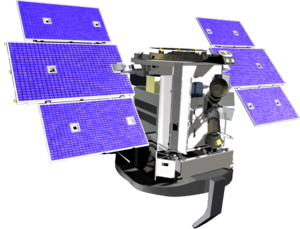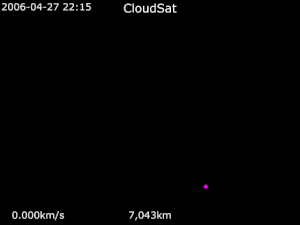CloudSat
 Artist's Concept of CloudSat | ||
| Mission type | Atmospheric research | |
|---|---|---|
| Operator | NASA | |
| COSPAR ID | 2006-016A | |
| SATCAT no. | 29107 | |
| Website | CloudSat home page | |
| Mission duration | Planned: 22 months Elapsed: 17 years, 11 months, 29 days | |
| Spacecraft properties | ||
Ball Aerospace | ||
| Launch mass | 700 kg (1,543 lb) | |
| Dimensions | 2.54 × 2.03 × 2.29 m (8.3 × 6.7 × 7.5 ft) (H × L × W) | |
| Start of mission | ||
| Launch date | April 28, 2006, 10:02:16 UTC | |
| Rocket | SLC-2W | |
| End of mission | ||
| Disposal | Passivation | |
| Deactivated | December 20, 2023, 11:10:30 UTC | |
| Last contact | 23 April 2024 (Decommissioned) | |
| Orbital parameters | ||
| Reference system | Semi-major axis 7,080.59 km (4,399.67 mi) | |
| Eccentricity | 0.0000824 | |
| Perigee altitude | 709 km (441 mi) | |
| Apogee altitude | 710 km (440 mi) | |
| Inclination | 98.23 degrees | |
| Period | 98.83 minutes | |
| RAAN | 330.82 degrees | |
| Argument of perigee | 91.62 degrees | |
| Mean anomaly | 14.57 degrees | |
| Mean motion | 14.57 | |
| Epoch | 25 January 2015, 03:10:38 UTC[1] | |
| Revolution no. | 46,515 | |
CloudSat is a
It operated in daytime-only operations from 2011 to 2023 due to battery malfunction, requiring sunlight to power the radar. On December 20, 2023, the Cloud Profiling Radar was deactivated for the final time, ending the data collection portion of the mission.
The mission was selected under NASA's
CloudSat's primary mission was scheduled to continue for 22 months to allow more than one seasonal cycle to be observed.
Instrument

The main instrument on CloudSat was the Cloud Profiling Radar (CPR), a 94-GHz nadir-looking radar that measures the power
The CPR capitalized on existing radar expertise and experience at JPL. Other radars already flown successfully or developed by JPL include the
Based on radar lifetime data, NASA expected the radar to operate for at least three years with a 99% probability.
CloudSat is managed by the Jet Propulsion Laboratory. Colorado State University provides scientific leadership and science data processing and distribution. The cost of this project was approximately $200 million.[3]
Impact on radio astronomy
Power levels of the CloudSat radar were such that the receiver electronics deployed on a typical radio telescope could be burned out if the telescope was pointing at the zenith during an overflight. Moreover, the typical receiver would probably saturate during an overflight (or near overflight) no matter where the radio telescope were pointed, and similarly strong signal levels would have been received if a telescope pointed at or near CloudSat whenever the satellite was above the horizon (which could be of order one hour per day at a typical location). The narrow-band, Doppler-shifted radar signal would probably have been detectable in even fairly short integrations no matter where a radio telescope were pointed, whenever CloudSat was above the horizon.[4][5][6]
See also
- A-train (satellite constellation)
- Earth Observing System
- List of spaceflights (2006)
References
- ^ "CLOUDSAT Satellite details 2006-016A NORAD 29107". N2YO. 25 January 2015. Retrieved 25 January 2015.
- ISSN 0003-0007.

- ^ "CloudSat Press Kit" (PDF). NASA/JPL.
- ^ "Radio Astronomy and CloudSat". Scientific Committee on Frequency Allocations for Radio Astronomy and Space Science. Retrieved 13 March 2020.
- ^ "CLOUDSAT - consequences for Radio Astronomy". Institut de Radioastronomie Millimétrique. Retrieved 13 March 2020.
- ^ Liszt, Harvey (2020-01-08). "Radio Astronomy in a New Era of Satellite Radiocommunication". AAS 235. p. 27m08s. Archived from the original on 2021-12-21. Retrieved 13 March 2020.
